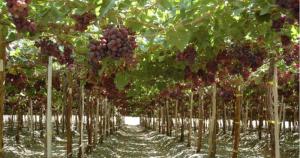
Why Chile’s Vineyards Are Flying High
These are boom times for the vineyards of Chile. The most recent figures from the International Organization of Vine and Wine reveal a record year for the South American nation, with wine production up 23%.

Chilean wine has long been considered good value for money, a reliable, inexpensive and safe everyday option. Wine Spectator, the top wine magazine in the US made Lapostolle Clos Apalta 2005 its Wine of the Year in 2008. The price of Clos Apalta depends on the harvest year but starts at around £40. Wine Spectator also tends to include Concha y Toro’s Don Melchor among the top ten wines in the world.
A combination of reasons explains the successful growth of the Chilean wine industry.
- Geographical diversity helps.
The first good Chilean wines were made in the fertile valleys in the country’s centre. But more recently it has been found that many wines improve when the vineyards are close to the Pacific Ocean, for example, or at high altitude in the Andes, or up the hillsides instead of down at the valley bottom, or in particular types of soil. There are a lot of variables.
Old wine areas abandoned for decades or even centuries, have been rediscovered, and completely new areas identified. New grape varieties are tested and new technologies developed or invested in.
- Favourable conditions
Favourable politics and economics have helped, too. Macroeconomic conditions in Chile have been stable for a long time. There is no inflation and little corruption. Foreign investment is welcome too – an opportunity embraced by winemakers and entrepreneurs from Spain (including Miguel Torres, pioneer of Chilean wine modernisation since the 1970s), France, California, Italy, Portugal, Norway and Switzerland, to name a few.
Foreign Contributions:
Chilean wine is not a foreign-only, or even foreign-mostly, activity. Exports were pioneered in the 1980s by Aurelio Montes. The largest wine exporter, Concha y Toro, is Chilean-owned and -staffed. The company is admired worldwide for its consistently high quality, entrepreneurial flair, its wide range of products, an ever present sales force (they export to over 130 countries) and dynamic marketing, including their mid-price brand Casillero del Diablo’s sponsorship of Manchester United.
There are also important scale economies in international distribution. The large wineries engage in aggressive marketing and pricing with supermarket chains and distribution firms.

Small producers and knowledge workers:
Supply is characterised by diversity and heterogeneity. Some very successful, internationally-respected Chilean wines are made by innovative firms which are often little more than one-man (or one-woman) operations. For example, the Vigno group makes carignan only, under very specific requirements, in the Maule region. Sometimes small producers benefit from positive knock-on effects generated by the large exporters.
There are several hundred highly-qualified local winemakers now in Chile, a critical mass of knowledge workers without whom there would have been no Chilean wine “miracle”. These experts regularly exchange knowledge with each other, not only with local neighbours in their respective geographical clusters, but also in a lively national knowledge network of conferences, tastings and competitions.
Conclusion:
Not even Chilean wine is perfectly free of dangers and risks. The new knowledge workers and some traditional owners do not always agree, and principal-agent conflicts have emerged in the past. Chile is prone to both earthquakes and challenges to the current free-market political economy model. Then there is global warming, which may eventually force wineries to move plantations many miles to the south of the country, with uncertain results. And there is no limit to how much competition may appear: there are many good places to make excellent wines around the world, and people everywhere are learning how to do it.
But clearly the Chilean wine experience offers some useful pointers to other developing nations. Its success suggests that primary commodity exporting does not need to be an eternal curse, especially with sound macro and microeconomic policies, and under positive political and economic conditions.